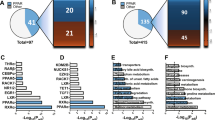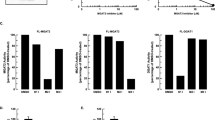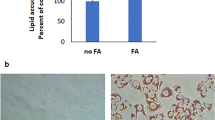Abstract
AIM: Phospholipid transfer protein (PLTP) and cholesteryl ester transfer protein (CETP) are key enzymes in lipoprotein metabolism facilitating the transfer and exchange of cholesteryl esters, triglycerides and phospholipids between lipoproteins. In the study presented here, we investigated the influence of two hormones—the adipocyte-derived hormone leptin as well as insulin on the hepatic secretion of both, PLTP and CETP.
METHODS: PLTP activity and CETP concentration—measured by exogenous substrate assay and enzyme-linked immunosorbent assay—were determined in supernatant of human hepatoma cell line HepG2 after single or combined exposure to leptin and insulin at physiological and supraphysiological concentrations, respectively. Messenger-RNA of PLTP and CETP was quantified by Northern blot analysis.
RESULTS: Leptin suppressed PLTP activity and CETP-concentration by up to 33% and 23%, respectively. Insulin also suppressed PLTP activity by up to 11% and CETP-concentration by up to 16%. In combination, the two hormones had additive suppressive effects for both, PLTP activity and CETP-concentration. Northern blot analysis showed no difference in m-RNA levels after exposure to leptin or insulin.
CONCLUSIONS: Leptin and insulin, both known to increase with body fat mass, suppress production of PLTP and CETP in HepG2 cells. When extrapolated to the in vivo situation, this suppressive effect may constitute a mechanism counteracting the potentially harmful action of lipid transfer proteins, particularly reduction of HDL-cholesterol, in conditions frequently associated with increased plasma triglyceride levels such as obesity and insulin resistance.
This is a preview of subscription content, access via your institution
Access options
Subscribe to this journal
Receive 12 print issues and online access
$259.00 per year
only $21.58 per issue
Buy this article
- Purchase on Springer Link
- Instant access to full article PDF
Prices may be subject to local taxes which are calculated during checkout



Similar content being viewed by others
References
Tall A . Plasma lipid transfer proteins Annu Rev Biochem 1995 64: 235–257.
Jauhiainen M, Metso J, Pahlman R, Blomquist S, van Tol A, Ehnholm C . Human plasma phospholipid transfer protein causes high density lipoprotein conversion J Biol Chem 1993 268: 2032–2036.
Tu A, Nishida HI, Nishida T . High density lipoprotein conversion mediated by human plasma phospholipid tansfer protein J Biol Chem 1993 268: 223098–223105.
Albers JJ, Wolfbauer G, Cheung MC, Day JR, Ching AFT, Lok S, Tu A . Functional expression of human and mouse plasma phospholipid transfer protein: effect of recombinant and plasma PLTP on HDL subspecies Biochim Biophys Acta 1995 1258: 27–34.
Lusa S, Jauhiainen M, Metso J, Somerharju P, Ehnholm C . The mechanism of human plasma phospholipid transfer protein induced enlargement of high density lipoprotein particles. Evidence for particle fusion Biochem J 1996 313: 275–282.
Von Eckardstein A, Jauhiainen M, Huang Y, Metso J, Langer C, Pussinen P, Wu S, Ehnholm C, Assmann G . Phospholipid transfer protein mediated conversion of high density lipoproteins generates preB1-HDL Biochim Biophys Acta 1996 1301: 255–262.
Castro GR, Fielding CJ . Early incorporation of cell-derived cholesterol into pre-beta-migrating high density lipoprotein Biochemistry 1988 27: 25–29.
Morton RE, Zilversmit DB . Purification and characterization of lipid transfer protein(s) from human lipoprotein-deficient plasma J Lipid Res 1982 23: 1058–1067.
Tall AR . Plasma cholesteryl ester transfer protein J Lipid Res 1993 34: 1255–1274.
Patsch JR, Prasad S, Gotto AM, Jr . Bengtsson Olivecrona G. Postprandial lipemia. A key for the conversion of high density lipoprotein2 into high density lipoprotein3 by hepatic lipase J Clin Invest 1984 74: 2017–2023.
Patsch JR, Prasad S, Gotto AM, Jr . Patsch W. High density lipoprotein2. Relationship of the plasma levels of this lipoprotein species to its composition, to the magnitude of postprandial lipemia, and to the activities of lipoprotein lipase and hepatic lipase J Clin Invest 1987 80: 341–347.
Dullaart RPF, Sluiter WJ, Dikkeschei LD, Hoogenberg K, Von Tol A . Effect of adiposity on plasma lipid transfer protein activities: a possible link between insulin resistance and high density lipoprotein metabolism Eur J Clin Invest 1994 24: 188–194.
Arai T, Yamashita S, Hirano K, Sakai N, Kotani K, Fujioka S, Nozaki S, Keno Y, Yamane M, Shinohara E, Islam AHM, Ishigami M, Nakamura T, Kameda-Takemura K, Tokunaga K, Matsuzawa Y . Increased plasma cholesteryl ester transfer protein in obese subjects Arterioscler Thromb 1994 14: 1129–1136.
Frayn KN, Coppack SW . Insulin resistance, adipose tissue and coronary heart disease Clin Sci 1992 82: 1–8.
Laakso M, Sarlund H, Mykkänen L . Insulin resistance is associated with lipid and lipoprotein abnormalities in subjects with varying degrees of glucose tolerance Arteriosclerosis 1990 10: 223–231.
Reaven GM . Role of insulin resistance in human disease Diabetes 1988 37: 1595–1607.
Arii K, Suehiro T, Yamamoto M, Ito H, Hashimoto K . Suppression of plasma cholesteryl ester transfer protein activity in acute hyperinsulinemia and effect of plasma nonesterified fatty acid Metabolism 1997 46: 1166–1170.
Sutherland WH, Walker RJ, Lewis-Barned NJ, Pratt H, Tillman HC . The effect of acute hyperinsulinemia on plasma cholesteryl ester transfer protein activity in patients with non-insulin-dependent diabetes mellitus and healthy subjects Metabolism 1994 43: 1362–1364.
Riemens SC, van Tol A, Sluiter WJ, Dullaart RPF . Plasma phospholipid transfer protein activity is lowered by 24-h insulin and acipimox administration Diabetes 1999 48: 1631–1637.
Riemens SC, van Tol A, Sluiter WJ, Dullaart RPF . Plasma phospholipid transfer protein activity is related to insulin resistance: impaired acute lowering by insulin in obese type 2 diabetic patients Diabetologia 1998 41: 929–934.
van Tol A, Ligtenberg JJ, Riemens SC, van Haeften TW, Reitsma WD, Dullaart RPF . Lowering of plasma phospholipid transfer protein activity by acute hyperglycaemia-induced hyperinsulinaemia in healthy men Scand J Clin Lab Invest 1997 57: 147–157.
Bagdade JD, Lane JT, Subbaiah PV, Otto ME, Ritter MC . Accelerated cholesteryl ester transfer in noninsulin-dependent diabetes mellitus Atherosclerosis 1993 104: 69–77.
Considine RV, Sinha MK, Heiman ML, Kriauciunas A, Stephens TW, Nyce MR, Ohannesian JP, Marco CC, McKee LJ, Bauer TL et al. Serum immunoreactive-leptin concentrations in normal-weight and obese humans New Engl J Med 1996 334: 292–295.
Considine RV, Caro JF . Pleiotropic cellular effects of leptin Curr Opin Endocrinol Diabetes 1999 6: 163–169.
Auwerx J . Leptin Lancet 1998 351: 737–742.
Cioffi JA, Shafer AW, Zupancic TJ, Smith-Gbur J, Mikhail A, Platika D, Snodgrass HR . Novel B219/OB receptor isoforms: possible role of leptin in hematopoiesis and reproduction Nature Med 1996 2: 585–589.
Lee GH, Proenca R, Montez JM, Carroll KM, Darvishzadeh JG, Lee KJ, Friedman JM . Abnormal splicing of the leptin receptor in diabetic mice Nature 1996 379: 632–635.
Tartaglia LA, Dembski M, Weng X, Deng N, Culpepper J, Devos R, Richards GJ, Campfield A, Clark FT, Deeds J, Muir C, Sanker S, Moriarty A, Moore KJ, Smutko JS, Mays GG, Woolf EA, Monroe CA, Tepper RI . Identification and expression cloning of a leptin receptor, OB-R Cell 1995 83: 1263–1271.
Silver DL, Jiang XC, Tall AR . Increased high density lipoprotein (HDL), defective hepatic catabolism of ApoA-I and ApoA-II, and decreased ApoA-I mRNA in ob/ob mice. Possible role of leptin in stimulation of HDL turnover J Biol Chem 1999 274: 4140–4146.
Cohen B, Novick D, Rubinstein M . Modulation of insulin activities by leptin Science 1996 274: 1185–1188.
Podskalny JM, Takeda S, Silverman RE, Tran D, Carpentier JL, Orci L, Gorden P . Insulin receptors and bioresponses in a human liver cell line (Hep G-2) Eur J Biochem 1985 150: 401–407.
Magee AI, Siddle K . Insulin and IGF-1 receptors contain covalently bound palmitic acid J Cell Biochem 1988 37: 347–357.
Dashti N, Wolfbauer G . Secretion of lipids, apolipoproteins, and lipoproteins by human hepatoma cell line, HepG2: effects of oleic acid and insulin J Lipid Res 1987 28: 423–436.
Javitt NB . HepG2 cells as a resource for metabolic studies: lipoprotein, cholesterol, and bile acids FASEB J 1990 4: 161–168.
Guo Z, Yuan C, Wei-Lavery T, Fang Y, Garvin RA, Nishida HI, Nishida T . Secretion of phospholipid transfer protein by human hepatoma cell line, HepG2, is enhanced by sodium butyrate J Nutr 1999 129: 1984–1991.
Lowry OH, Rosebrough NJ, Farr AI, Randall RJ . Protein measurement with the Folin phenol reagent J Biol Chem 1951 192: 265–270.
Föger B, Santamarina-Fojo S, Shamburek RD, Parrot CL, Talley GD, Brewer HBJ . Plasma phospholipid transfer protein. Adenovirus-mediated overexpression in mice leads to decreased plasma high density lipoprotein (HDL) and enhanced uptake of phospholipids and cholesteryl esters from HDL. J Biol Chem 1997 272: 27393–27400.
Damen J, Regts J, Scherphof G . Transfer of (14C)phosphatidylcholine between liposomes and human plasma high density lipoprotein. Partial purification of a transfer-stimulating plasma factor using a rapid transfer assay. Biochim Biophys Acta 1982 712: 444–452.
Speijer H, Groener JE, van Ramshorst E, van Tol A . Different locations of cholesteryl ester transfer protein and phospholipid transfer protein activities in plasma Atherosclerosis 1991 90: 159–168.
Patsch JR, Patsch W . Zonal ultracentrifugation Meth Enzymol 1986 129: 3–26.
Ritsch A, Auer B, Foger B, Schwarz S, Patsch JR . Polyclonal antibody-based immunoradiometric assay for quantification of cholesteryl ester transfer protein J Lipid Res 1993 34: 673–679.
Ritsch A, Doppler W, Pfeifhofer C, Sandhofer A, Bodner J, Patsch JR . Cholesteryl ester transfer protein gene expression is not specifically regulated by CCAAT/enhancer-binding protein in HepG2-cells Atherosclerosis 1999 146: 11–18.
Ritsch A, Drexel H, Amann FW, Pfeifhofer C, Patsch JR . Deficiency of cholesteryl ester transfer protein. Description of the molecular defect and the dissociation of cholesteryl ester and triglyceride transport in plasma. Arterioscler Thromb Vasc Biol 1997 17: 3433–3441.
Castelli WP, Doyle JT, Gordon T, Hames CG, Hjortland MC, Hulley SB, Kagan A, Zukel WJ . HDL-cholesterol and other lipids in coronary heart disease: the cooperative lipoprotein phenotyping study Circulation 1977 55: 767–772.
Gordon DJ, Probstfield JL, Garrison RJ, Neaton JD, Castelli WP, Knoke JD, Jacobs DRJ, Bangdiwala S, Tyroler HA . High-density lipoprotein cholesterol and cardiovascular disease. Four prospective American studies. Circulation 1989 79: 8–15.
Gordon T, Castelli WP, Hjortland MC, Kannel WB, Dawber TR . High density lipoprotein as a protective factor against coronary heart disease Am J Med 1977 62: 707–714.
Miller GJ, Miller NE . Plasma high density lipoprotein concentration and development of ischemic heart disease Lancet 1975 i: 16–19.
Ehnholm S, van Dijk KW, van't Hof B, van der Zee A, Olkkonen VM, Jauhiainen M, Hofker M, Havekes L, Ehnhom C . Adenovirus mediated overexpression of human phospholipid transfer protein alters plasma HDL levels in mice J Lipid Res 1998 39: 1248–1253.
van Haperen R, van Tol A, Vermeulen P, Jauhiainen M, van Gent T, van den Berg JJ, Ehnholm S, Grosveld F, van der Kamp A, de Crom R . Human Plasma phospholipid transfer protein increases the antiatherogenic potential of high density lipoproteins in transgenic mice Arterioscler Thromb Vasc Biol 2000 20: 1082–1088.
Jiang XC, Bruce C, Mar J, Lin M, Ji Y, Francone OL, Tall AR . Targeted mutation of plasma phospholipid transfer protein gene markedly reduces high-density lipoprotein levels J Clin Invest 1999 103: 907–914.
Brown ML, Inazu A, Hesler CB, Agellon LB, Mann C, Whitlock ME, Marcel YL, Milne RW, Koizumi J, Mabuchi H et al. Molecular basis of lipid transfer protein deficiency in a family with increased high-density lipoproteins Nature 1989 342: 448–451.
Inazu A, Hesler CB, Koizumi J, Takata K, Maruhama Y, Mabuchi H, Tall AR . Increased high-density lipoprotein levels caused by a common cholesteryl-ester transfer protein gene mutation New Engl J Med 1990 323: 1234–1238.
Agerholm-Larsen B, Nordestgaard BG, Steffensen R, Jensen G, Tybjaerg-Hansen A . Elevated HDL cholesterol is a risk factor for ischemic heart disease in white women when caused by a common mutation in the cholesteryl ester transfer protein gene Circulation 2000 101: 1907–1912.
Hirano K, Yamashita S, Nakajima N, Arai T, Maruyama T, Yoshida Y, Ishigami M, Sakai N, Kameda-Takemura K, Matsuzawa Y . Genetic cholesteryl ester transfer protein deficiency is extremely frequent in the Omagari are of Japan. Marked hyperalphalipoproteinemia caused by CETP gene mutation is not associated with longevity. Aterioscler Thromb Vasc Biol 1997 17: 1053–1059.
Jiang X, Moulin P, Quinet E, Goldberg IJ, Yacoub LK, Agellon LB, Compton D, Polokoff R, Tall AR . Mammalian adipose tissue and muscle are major sources of lipid transfer protein m-RNA J Biol Chem 1991 266: 4631–4639.
Radeau T, Robb M, Lau P, Borthwick J, McPherson R . Relationship of adipose tissue cholesteryl ester transfer protein (CETP) mRNA to plasma concentrations of CETP in man Atherosclerosis 1998 139: 369–376.
Albers JJ, Tu A, Wolfbauer G, Cheung MC, Marcovina SM . Molecular biology of phospholipid transfer protein Curr Opin Lipidol 1996 7: 88–93.
Acknowledgements
The authors wish to thank Ronald W Clark (Department of Cardiovascular and Metabolic Diseases, Pfizer Inc.) for kindly providing the monoclonal anti CETP antibody, Professor Gunilla Olivecrona (Department of Medical Biochemistry and Biophysics, University of Umea, Sweden) for kindly providing the anti hepatic lipase antibody, and Dr Heinz Zoller (Department of Internal Medicine, University of Innsbruck) for kindly providing the plasmid containing the cDNA of GAPDH. This work was supported by grant P 11693-Med of the Austrian FWF (to JR Patsch), and by grant Nr. 6442 of the Österreichische Nationalbank (to JR Patsch).
Author information
Authors and Affiliations
Corresponding author
Rights and permissions
About this article
Cite this article
Kaser, S., Föger, B., Ebenbichler, C. et al. Influence of leptin and insulin on lipid transfer proteins in human hepatoma cell line, HepG2. Int J Obes 25, 1633–1639 (2001). https://doi.org/10.1038/sj.ijo.0801807
Received:
Revised:
Accepted:
Published:
Issue Date:
DOI: https://doi.org/10.1038/sj.ijo.0801807



